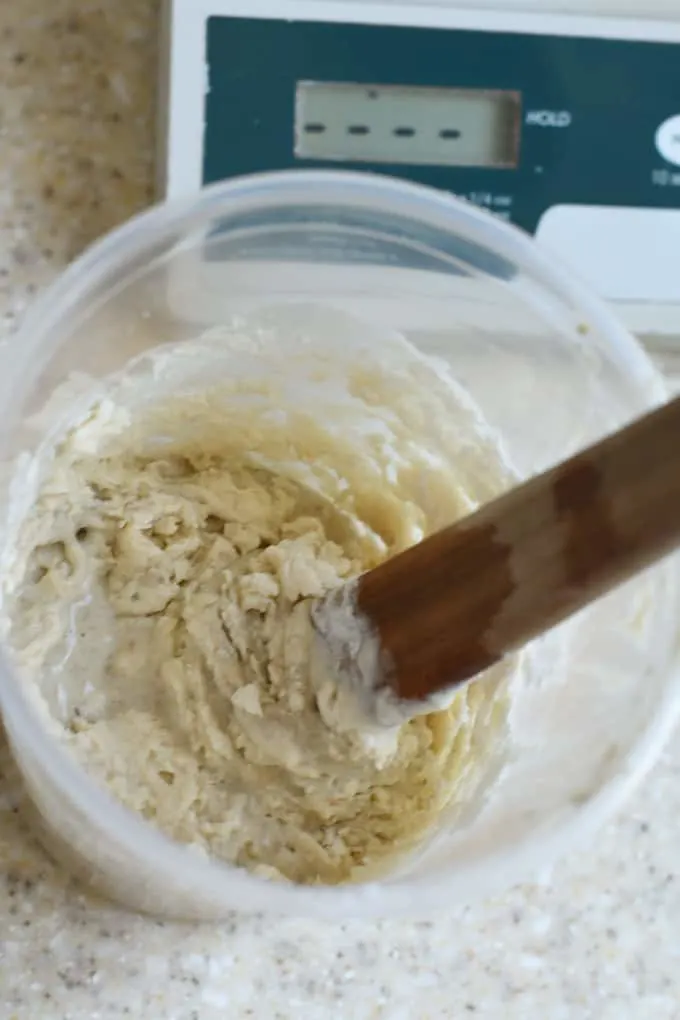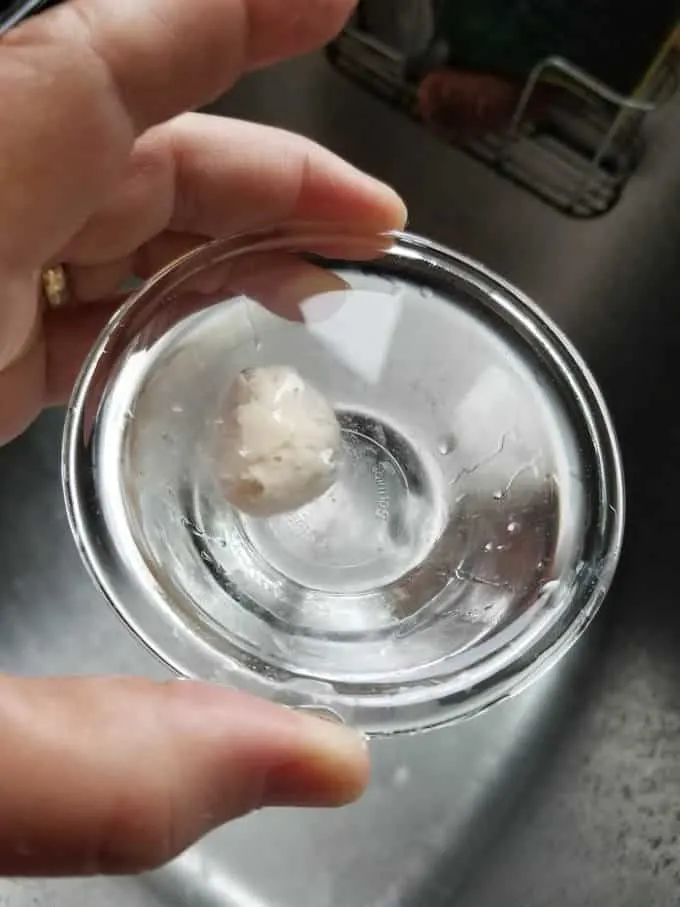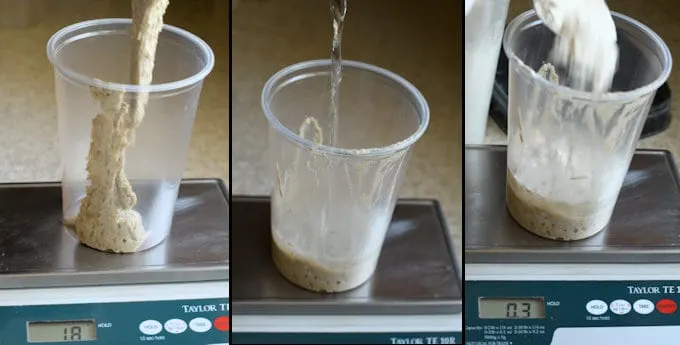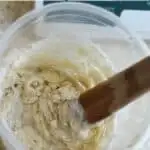How to Feed & Maintain your Sourdough Starter
You’ve done it! You’ve created a living batter filled with wild yeast. Now let’s see how to feed & maintain your sourdough starter.
If you haven’t made your starter yet, visit this post to see how to make a sourdough starter from scratch.

Right off the bat I’m going to say that there are a million ways to feed, maintain and use a sourdough starter. In fact, after you’re done reading this post, you should read through my instructions for How to keep a small sourdough starter to see of that method would work better for you.
I am going to outline for you how I maintain my sourdough starters. I tend to have a fairly relaxed attitude towards the process. It works for me and I think my approach can work for you if you don’t bake bread every single day (and even if you do).
At the end of the post you’ll find a how-to card that lists the ingredient amounts and steps to follow each time you feed your starter.
But first I’m going to give you all the how’s and why’s and try to answer any questions you might have.
Tips for using and maintaining your sourdough starter:
- Since I don’t bake every day, I keep my starters (yes, I have 3) in the refrigerator.
- If I’m making a 2-day recipe (most of mine are) I take the starter out of the refrigerator early in the morning of the day I’m making the dough. If the starter is inactive I feed it right away and it should be ready by early afternoon.
- If I’m making a 1-day recipe, I’ll take the starter out the night before and feed it if it’s inactive. It should be ready to use first thing in the morning.
- When the starter is cold from the refrigerator, I feed the starter using fairly warm water, warmer than body temp. The warm water will jump-start the cold starter.
- If the starter has been fed within the last 2-3 days, and has been refrigerated, you can probably go ahead and use it without feeding.
- If you’re not sure if the starter is active, drop a dollop into a bowl of water to see if it floats. If it does, it’s ready for baking.
- I write all my sourdough recipes to use 8 oz of active starter. After using 8 oz of starter in the recipe, I’m left with 4 oz of starter, exactly the right amount for feeding.

Schedule for feeding your sourdough starter:
- Your starter needs to be fed about 1x per week if refrigerated, and every day if left at room temperature.
- Generally, about 5-6 hours after feeding my starter is ready. The time may vary based on room temp, dough temp, etc. The starter should have doubled in volume and started to recede and/or pass the float test.
- I take my starter out of the refrigerator once a week for feeding, even if I’m not baking. Although, truth be told, I often go longer than a week between feedings and I haven’t killed it yet.
- Did you know you can dry your sourdough starter? Dried starter can be kept indefinitely.
- After you’ve removed the portion of starter for baking, feed the starter again and leave it at room temperature for 3-4 hours before putting it back in the refrigerator.

FAQs about feeding & maintaining Sourdough Starter:
Honestly, I’ve gone longer than a month without feeding my starter and I haven’t killed it yet. Give it a feeding and see if it wakes up. If it’s alive, keep feeding it until it is reliably doubling in size within 4-5 hours.
If you go more than about 2 weeks between feedings, you might want to give the starter 2-3 feedings before using. A starter that hasn’t been fed for weeks will be quite sluggish and your dough won’t be as lively.
If your starter was fed a day or two before, it’s possible to use the starter straight from the refrigerator. Give it a float test to make sure it’s active. The dough may take a little longer to ferment since the temperature of the dough will be colder.
It’s called “hooch” and don’t worry, your starter is still alive. Just stir that water back into the starter before feeding. Again, you might need 2 feedings to completely revive the starter since it’s been quite dormant.
To maintain your starter at 100% hydration it is best and most accurate to weigh your ingredients. If you’re just a little bit off every time you feed, eventually, your starter could be thrown out of balance.
No problem, use the amount of starter called for in the recipe. Then weigh out 4 oz of the remaining starter for feeding and discard the rest.
If you continually feed the starter without discarding, you’ll end up drowning in starter.
Yes, even if the discard is not active enough for baking bread, you can add it to many other recipes as a flavor and texture enhancer.
Unless you’re going away for an extended time, your starter should be just fine for a couple of weeks in the refrigerator. If you’ll be gone really long-term, put the starter into the freezer or dry it. Frozen or dried starter will need several feedings to rejuvenate.
If you appreciate this detailed information, I’d really appreciate a 5-star review.
How to Feed Sourdough Starter
Ingredients
- 4 oz unfed sourdough starter
- 4 oz all purpose flour
- 4 oz water (room temperature)
Instructions
- Weigh 4 oz of your unfed starter into a clean container. Discard the extra starter (see note)4 oz unfed sourdough starter
- Add the flour and water and mix until combined. Set aside at room temperature.4 oz all purpose flour, 4 oz water
- The starter is ready to use when it has doubled in volume and a small spoonful floats when dropped into a bowl of water. This generally takes 4-5 hours but the time can vary based on dough temperature and room temperature.
- If you do not plan to bake with the starter on the day it is fed, refrigerate 3-4 hours after feeding.
- Feed refrigerated starter weekly. If you go longer than a week without feeding, you may want to give the starter two feedings before using.
Would you like to save this recipe?
As an Amazon Associate and member of other affiliate programs, I earn from qualifying purchases.







If I feed the starter at night should I leave it out overnight to use to make dough in the morning?
Yes. By morning is should be nice and active.
If I want to save discard for new starters for family do I feed it then refrigerate till I can deliver them?Thanks
Yes, exactly. Just use the discard (4oz) to create a new starter and maintain until you can deliver it. Happy Baking!
Thank you, your site has been very informative for me.
If you’re discarding a portion of the starter but you want to use it the next day in baking, can you save the discard In the fridge for use? Or do you have to use it that same day?
Do you keep your starter at room temp? If you do, why not just refrigerate the entire starter then take it out the next day and use what you need and feed the starter then? If you keep the starter refrigerated just wait a day to feed it. Hope that answers your question.
I am confused. Do I throw away the bulk of the stater every week if in frig and reduce my starter down to 1/2 c if I am not using it to bake that week…I was confused by your explanation above. Why are you discarding 2oz to have 18oz?
You should always have 12 oz of starter as the base. Each time you feed the starter you either discard (if it’s not active) or use (if it is active) 8 oz of the starter. The remaining 4 oz is combined with 4 oz of water and 4 oz of flour to regenerate the starter base back to 12 oz. For folks who bake every day or several times per week, the starter will remain active and the 8 oz that is removed can be used right away for baking. For folks who bake less often and store the starter in the fridge between baking sessions the starter will go dormant in the refrigerator. In other words, the yeast has eaten most of the food available from the previous feeding and needs more food before it’s active enough for baking. In that case you must to discard the 8 oz of starter because it’s not active enough for baking. The previous comment about the 18 oz of starter is specifically for someone who was interested in doing a double bake in one day. You can ignore those numbers if you only plan to bake 1 recipe at a time. I hope this answers your question. Ask me if you need more clarification.
Brand new to sourdough starters and your blog is serving as my life line. I want to make sure I understand this discard correctly because I was given a small amount and am trying to work up to storing a larger starter (LOVE your small starter page btw). I was getting really confused about where my discard would come from if I maintained 12oz but I THINK I get it now… If I want to maintain 12oz but will probably only bake once a week I would…
1. Pull out my starter from fridge
2. Discard 8oz bc it’s likely gone dormant (correct?)
3. Feed remaining 4 back to 12oz
4. Use 8oz for the recipe I want
5. Feed the remaining 4oz again to be back to a base starter of 12oz
Right? And I could take out and feed my starter the night before- leave it out overnight. Then I’d have 8oz ready to use by morning, correct?
Hi Katherine. Sourdough is not a straightforward business so it’s sometimes hard to give a concrete answer. If you want to keep a larger 12 oz starter than what you’re listing is basically correct. All my recipes use 8 oz of either starter or discard. If your starter has been in the refrigerator for a week or two and hasn’t been fed then you will remove and discard (or use in a discard recipe) 8 oz of starter. Feed the remaining to bring back to 12 oz. Use that fed starter to bake a sourdough recipe within the next day. When you pull off 8 oz of fed starter for the recipe feed again and refrigerate. I have found that if I’ve fed my starter and it’s only been in the fridge for a day or two I can go ahead and use it for a sourdough recipe without feeding first.
Good morning, people who know everything are not always good teachers.
I have been reading and learning about sourdough baking for three months and this is the first time I have seen the proper ratio of starter to flour to water for the feeding of the starter.
For me, I only use grams so I need to do some conversion sometimes.
I am learning very useful information, thanks.
I enjoy your website and recipes. Thank you.
I have a dumb question…When feeding a starter, do I need to measure 4 oz. each time and discard and then add that or add to the starter without discarding what I have in container?
Another question…Can I have 8 oz. of starter then add 8 oz. of AP flour and water to that?
I would like to make sourdough bread and pretzels the same day. so I need to make sure that I have enough sourdough starter.
This is my first time making starter so it is trial & error for me.
Thanks
Let me see if I can answer your question. The way I have my starter recipe written you should always have 12 oz of starter as your base. Each time you feed the starter you take out 4 oz of the unfed starter and combine it with 4 oz of flour and 4 oz of water. Discard (or use) the remaining 8 oz of starter. The main thing to remember is that you always feed with equal weights of starter-water-flour. That way the starter doesn’t get out of balance. If you want to do a double bake in one day you could remove the 4 oz and feed. Set that aside as your base starter. You’re now left with 8oz. I would discard 2 oz so you’re left with 6oz. Feed that 6oz with 6oz of water 6oz of flour. You’ll have a total of 18oz. When that starter is active and ready, use what you need for the two recipes and you should just have to discard the leftover 2oz. Does that make sense?
That’s a great answer for, me, too! Thanks! You’re my sourdough guru, Eileen!
I had this EXACT question with the starter instructions i’m following! Glad its explained here, thank you for asking 🙂